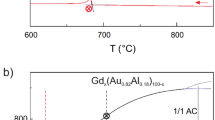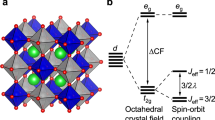Abstract
Fluoride phases that contain the spin-1/2 4d 9 Ag(II) ion have recently been predicted to have interesting or unusual magnetochemistry, owing to their structural similarity to the 3d 9 Cu(II) cuprates and the covalence associated with this unusual oxidation state of silver. Here we present a comprehensive study of structure and magnetism in the layered Ag(II) fluoride Cs2AgF4, using magnetic susceptometry, inelastic neutron scattering techniques and both X-ray and neutron powder diffraction. We find that this material is well described as a two-dimensional ferromagnet, in sharp contrast to the high-TC cuprates and a previous report in the literature. Analyses of the structural data show that Cs2AgF4 is orbitally ordered at all temperatures of measurement. Therefore, we suggest that orbital ordering may be the origin of the ferromagnetism we observe in this material.
This is a preview of subscription content, access via your institution
Access options
Subscribe to this journal
Receive 12 print issues and online access
$259.00 per year
only $21.58 per issue
Buy this article
- Purchase on Springer Link
- Instant access to full article PDF
Prices may be subject to local taxes which are calculated during checkout




Similar content being viewed by others
References
Grochala, W. & Hoffmann, R. Real and hypothetical intermediate-valence Ag-II/Ag-III and Ag-II/Ag-I fluoride systems as potential superconductors. Angew. Chem. Int. Edn 40, 2742–2781 (2001).
Grochala, W., Porch, A. & Edwards, P. P. Meissner-Ochsenfeld superconducting anomalies in the Be–Ag–F system. Solid State Commun. 130, 137–142 (2004).
Muller-Rosing, H.-C., Schulz, A. & Hargittai, M. Structure and bonding in silver halides. A quantum chemical study of the monomers: Ag2X, AgX, AgX2 and AgX3 (X=F, Cl, Br, I). J. Am. Chem. Soc. 127, 8133–8145 (2005).
Grochala, W. & Edwards, P. P. “Unconventional covalent” KAgF3 is metallic above 50 K. Phys. Status Solidi B 240, R11–R14 (2003).
Grochala, W., Egdell, R. G., Edwards, P. P., Mazej, Z. & Zemva, B. On the covalency of silver-fluorine bonds in compounds of silver(I), silver(II) and silver(III). ChemPhysChem 4, 997–1001 (2003).
Muller-Buschbaum, H. On the crystal chemistry of oxoargentates and silver oxometallates. Z. Anorg. Allg. Chem. 630, 2125–2175 (2004).
Srochinski, D., Dziegiec, Y. & Grzejdziak, A. Ag(II) and Ag(III) complexes and Ag(II)/Ag(I) and Ag(III)/Ag(II) redox systems in the presence of heterocyclic amines. Russ. J. Coord. Chem. 23, 447–460 (1997).
Housecroft, C. E. Silver. Coord. Chem. Rev. 115, 141–161 (1992).
Odenthal, R. H., Paus, D. & Hoppe, R. Magnetochemistry of divalent silver. New fluoroargentates(II). Dicesium, dirubidium, and dipotassium tetrafluoroargentates. Z. Anorg. Allg. Chem. 407, 144–150 (1974).
Mermin, N. D. & Wagner, H. Absence of ferromagnetism or antiferromagnetism in one- or 2-dimensional isotropic Heisenberg models. Phys. Rev. Lett. 17, 1133–1137 (1966).
Moussa, F. & Villain, J. Spin-wave lineshape in 2-dimensional K2CuF4—neutron experiments and theory. J. Phys. C 9, 4433–4451 (1976).
Li, W. H. et al. Polarized neutron studies of forbidden magnons in the two-dimensional ferromagnet dipotassium tetrafluorocuprate(II). Phys. Rev. B 35, 1891–1898 (1987).
Hidaka, M., Inoue, K., Yamada, I. & Walker, P. J. X-ray diffraction study of the crystal structures of potassium copper fluoride (K2CuF4) and potassium copper zinc fluoride (K2CuxZn1−xF4) . Physica B& C 121, 343–350 (1983).
Khomskii, D. I. & Kugel, K. I. Orbital and magnetic structure of two-dimensional ferromagnets with Jahn-Teller ions. Solid State Commun. 13, 763–766 (1973).
Jahn, H. A. & Teller, E. Stability of polyatomic molecules in degenerate electronic states. I. Orbital degeneracy. Proc. R. Soc. A 161, 220–235 (1937).
Albright, T. A., Burdett, J. K. & Whangbo, M. H. Orbital Interactions in Chemistry (Wiley, London, 1985).
Koo, H. J. & Whangbo, M. H. Analysis of the spin exchange interactions in the extended magnetic solids K2NiF4, K2CuF4, La2CuO4, Nd2CuO4, KNiF3, and KCuF3 . J. Solid State Chem. 151, 96–101 (2000).
Hayes, W. & Wilkens, A. An investigation of the Ni+ ion in irradiated LiF and NiF. Proc. R. Soc. A 281, 340–365 (1964).
Garcia-Lastra, J. M., Aramburu, J. A., Barriuso, M. T. & Moreno, M. Impurities in noncubic crystals: stabilization mechanisms for Jahn-Teller ions in layered perovskites. Phys. Rev. Lett. 93, 226402 (2004).
Moritomo, Y. & Tokura, Y. Pressure-induced disappearance of the in-plane lattice distortion in layered cupric chloride: (C2H5NH3)2CuCl4 . J. Chem. Phys. 101, 1763–1766 (1994).
Mostovoy, M. V. & Khomskii, D. I. Orbital ordering in charge transfer insulators. Phys. Rev. Lett. 92, 167201 (2004).
Peterson, P. F., Gutmann, M., Proffen, T. & Billinge, S. J. L. PDFgetN: a user-friendly program to extract the total scattering structure factor and the pair distribution function from neutron powder diffraction data. J. Appl. Crystallogr. 33, 1192 (2000).
Larson, A. C. & von Dreele, R. B. Los Alamos National Laboratory Report LAUR86-748 (1986).
Baker, G. A., Gilber, H. E., Eve, J. & Rushbroo, Gs. On 2-dimensional spin-1/2 heisenberg ferromagnetic models. Phys. Lett. A 25, 207–209 (1967).
Acknowledgements
We would like to thank J. A. del Toro and the staff at the University of Liverpool for the use of their superconducting quantum interference device magnetometer, D. Scalapino, D. I. Khomskii and D. J. Singh for critical readings of the manuscript, and D. Argyriou for useful discussions. We would also like to thank W. Hayes for drawing our attention to relevant literature and S. Clarke for the use of a glove box. S.E.M. acknowledges support from the US National Science Foundation through award OISE-0404938. Financial support was also provided by the EU through the Human Potential Programme under IHP-ARI contract HPRI-CT-1999-00020, the Manuel Lujan Neutron Scattering Center, funded by the US Department of Energy Office of Basic Energy Sciences, and Los Alamos National Laboratory, funded by the US Department of Energy under contract W-7405-ENG-36. J.F.C.T. acknowledges the financial support of the US National Science Foundation, through a CAREER award (Grant No. CHE 0349010), and the University of Tennessee through the Neutron Sciences Consortium.
Author information
Authors and Affiliations
Corresponding authors
Ethics declarations
Competing interests
The authors declare no competing financial interests.
Rights and permissions
About this article
Cite this article
McLain, S., Dolgos, M., Tennant, D. et al. Magnetic behaviour of layered Ag(II) fluorides. Nature Mater 5, 561–565 (2006). https://doi.org/10.1038/nmat1670
Received:
Accepted:
Published:
Issue Date:
DOI: https://doi.org/10.1038/nmat1670
This article is cited by
-
Silverland: the Realm of Compounds of Divalent Silver—and Why They are Interesting
Journal of Superconductivity and Novel Magnetism (2018)
-
Crystal and electronic structures and high-pressure behavior of AgSO4, a unique narrow band gap antiferromagnetic semiconductor: LDA(+U) picture
Journal of Molecular Modeling (2011)
-
On possible existence of pseudobinary mixed valence fluorides of Ag(I) / Ag(II): a DFT study
Journal of Molecular Modeling (2011)
-
Ligation of Aza bases to the AgF2 molecule: a theoretical study
Journal of Molecular Modeling (2008)
-
Small changes, big consequences
Nature Materials (2006)



